
The Pennine Alps, also known as the Valais Alps, are a mountain range in the western part of the Alps. They are located in Switzerland (Valais) and Italy.
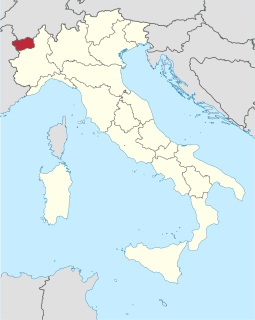
The Aosta Valley is a mountainous autonomous region in northwestern Italy. It is bordered by Auvergne-Rhône-Alpes, France, to the west, Valais, Switzerland, to the north and by Piedmont, Italy, to the south and east. The regional capital is Aosta.

Aosta is the principal city of Aosta Valley, a bilingual region in the Italian Alps, 110 km (68 mi) north-northwest of Turin. It is situated near the Italian entrance of the Mont Blanc Tunnel, at the confluence of the Buthier and the Dora Baltea, and at the junction of the Great and Little St. Bernard routes.
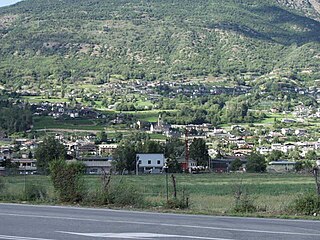
Saint-Christophe is a town and comune in the Aosta Valley. It is located east of Aosta, on the left shore of the Dora Baltea.

Doire was a department of the French Consulate and of the First French Empire in present-day Italy. It was named after the river Dora Baltea. It was formed in 1802, when the Subalpine Republic was directly annexed to France. Its capital was Ivrea.
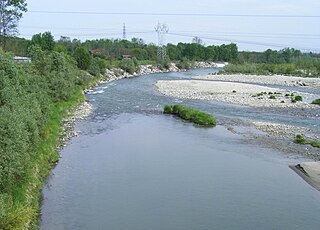
Dora Baltea or Doire Baltée is a river in northwestern Italy. It is a left-hand tributary of the Po and is about 170 kilometres (110 mi) long.

Saint-Nicolas is a town and comune in the autonomous region of Aosta Valley, in northern Italy. It consists of 13 hamlets located between 950 and 1,550 metres above sea level. Sitting like a balcony above the Dora Baltea Valley, Saint-Nicolas overlooks the four major lateral valleys of the mid-upper Aosta valley. These are ; Val de Cogne, Valsavarenche, Val de Rhêmes, and Valgrisenche.

Bionaz is a comune sparso which extends over 143 square kilometres (55 sq mi) of the North-Eastern Valpelline area of the Aosta Valley region of northwest Italy. The commune lies on the left side of the river Dora Baltea. The population of about 240 is dispersed among 20 or more small alpine villages and hamlets including Plan-de-Veyne, which is the main centre and the capoluogo. The commune belongs to the Unité des communes valdôtaines du Grand-Combin.

Gressoney-Saint-Jean is a town and comune in the Aosta Valley region of north-western Italy.

Pont-Saint-Martin ; Piedmontese: Pont San Martìn) is a town and comune in the Aosta Valley region of northwest Italy.

The Lys is a small 40 kilometres (25 mi) river which flows from the Lys Glacier on the south side of the Monte Rosa massif, at the foot of Vincent Pyramid, elevation 4,215 metres (13,829 ft), and runs through the Val de Gressoney, flanked by a road, before converging with the Dora Baltea as a right tributary at Pont-Saint-Martin.

Tête Blanche is a mountain of the Pennine Alps on the Swiss-Italian border. Its summit is the tripoint between the valleys of Hérens, Mattertal and Valpelline.

Val Ferret is the name of the two separate valleys, departing from the Col Ferret on the border between Italy and Switzerland, on the southern and eastern sides of the Mont Blanc Massif. The Swiss valley drains northeastwards towards Orsières and on into the Rhône basin; whereas the Italian valley drains southwestwards towards Courmayeur and on into the Po basin.

The Pont d'Aël is a Roman aqueduct, located in a village of the same name in the comune of Aymavilles in Aosta Valley, northern Italy. It was built in the year 3BC for irrigation purposes and supplying water for the newly founded colony of Augusta Praetoria, which is now known as Aosta. The water was directed through a neighbouring valley 66 m above the floor of the Aosta valley, through a sophisticated system. The aqueduct is 6km long in total. In addition to its unusual position, the construction, which was originally thought to be a three-story structure, shows more unique features such as a control corridor below the water line, as well as explicit private funding. Today, the water channel of the aqueduct serves as a public walking trail.
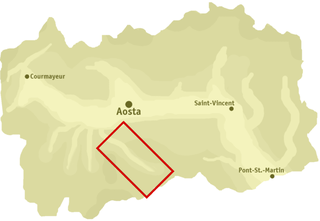
Val di Cogne (Italian) or Val de Cogne (French) - literally Cogne Valley - is a valley in the Aosta Valley, northern Italy. It takes its name from Cogne, the largest town in its area. Most of the valley is included in the Gran Paradiso National Park.

Fort Bard, also known as Bard Fort, is a fortified complex built in the 19th century by the House of Savoy on a rocky prominence above Bard, a town and comune in the Aosta Valley region of northwestern Italy. Fort Bard has been completely restored after many years of neglect. In 2006 it reopened to tourists as the Museum of the Alps, it has additional art exhibitions and galleries. In the summer, the main courtyard is used to host musical and theatrical performances.
The Valdigne is the upper part of the Aosta Valley in north-west Italy. It is traversed by the Dora Baltea, a tributary of the Po.

The Chiusella valley is a valley in the Province of Turin.
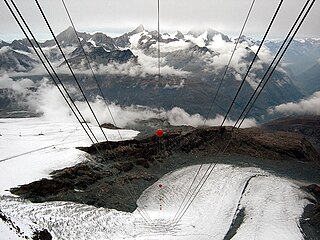
The Theodul Glacier is a glacier of the Alps, located south of Zermatt in the canton of Valais. It lies on the Swiss side of the Pennine Alps, although its upper basin touches the Italian region of the Aosta Valley. The glacier descends from the west side of the Breithorn and splits into two diverging branches above Gandegg: the Upper Theodul Glacier, spilling on a high plateau near Trockener Steg, together with the Furgg Glacier, and the Lower Theodul Glacier, reaching a height of about 2,500 metres (8,202 ft) above the Gorner Glacier. Both branches are part of the Rhone basin, through the rivers Gornera, Mattervispa, and Vispa. Slightly above the glacier splitting is the Theodul Pass, crossing the border between Switzerland and Italy, and connecting Zermatt to Breuil-Cervinia. On the west, the Theodul Glacier is overlooked by the Matterhorn.

The Brenva Glacier is a valley glacier, located on the southern side of the Mont Blanc massif in the Alps. It is the second longest and eighth largest glacier in Italy, and descends down into Val Veny, close to Entrèves, near Courmayeur. Over the centuries it has experienced a number of major rock avalanches which have shaped the glacier and influenced its movement.



















